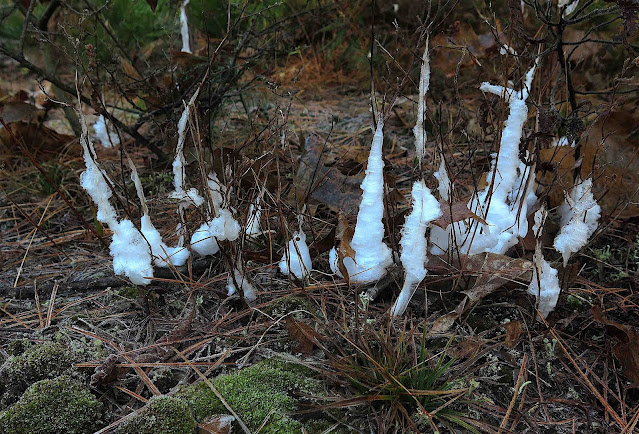If I needed further reassurance, the brittle needles of frost heaving up from the sandy powerline path convinced me that freezing cold still reigned down close to the ground, despite a morning sun warming my shoulders by now.
Even the fine-textured hoarfrost that coated these baby oak leaves was still intact, muting the colors of the leaves and outlining their shapes in sparkling crystals.
Baby oak leaves (Querqus species)And there it was! Frostweed doing its frosty thing, and in numbers I had never seen before at this site!
Canada Frostweed patch (Crocanthemum canadense)Here's a closer look at how the frothy ice curls around the split stems.
And as fragile as those icy curls are, it was still so cold, they had not yet begun to melt, even as the sun rose higher and found some of them.
The curls seemed much more frothy, this year, as if they had been formed from vapor instead of liquid. They looked like frozen clouds.
With this particular specimen, the icy mass appeared to have been formed from hair-fine threads and reminded me of cotton candy.
Once I had satisfied my quest for finding the Frostweed curls, I looked around the site for other icy transformations. The frost looked particularly pretty decorating these crimson oak leaves.
Leaves of a baby oak (Quercus sp.)Whole swaths of reddening Dewberry leaves were outlined in silver.
Northern Dewberry (Rubus flagellaris)The deep-red leaves of Lowbush Blueberry were fluffy with icy fur.
Lowbush Blueberry (Vaccinium angustifolium)Vast patches of Common Haircap Moss, punctuated with tiny tawny fungi, were sparkling with icy crystals.
British Soldiers Lichen (Cladonia cristatella)
Pretty clusters of Fan Clubmoss bore deep-green cedar-like flattened branches tipped with white.
Fan Clubmoss (Diphasiastrum digitatum), also known as Ground CedarAlso tipped with white frost were the rounder branches of this Tree Clubmoss, which appeared as if exploding from a patch of deep-pink Sphagnum Moss.
Tree Clubmoss (Dendrolycopodium dendroideum), over pink-colored Sphagnum Moss (species unknown)The branches of Running Clubmoss are often tipped with white hairs, which suggested its alternative vernacular name of Wolf's Claw Clubmoss. But today, all the hair-fine leaves were whitened by frost.
Running Clubmoss (Lycopodium clavatum)When I first arrived at this site this day, all the needles of small sapling pines were whitened by hoarfrost. But as the sun-warmed morning wore on, each needle became tipped with sparkling drops of melted ice.
As I prepared to leave, the mounting sun's rays had begun to warm the formerly shaded Frostweed curls. But rather than dripping water, the frothy ice just seemed to dissipate into the air, reinforcing my impression that the curls might have been formed from freezing mist instead of liquid sap. I wonder if anyone has ever filmed the process as the curls were forming. That would be something to see!


















5 comments:
What an amazing plant. Just beautiful! And those frosty leaves are nice too! No frost here yet.
Nature is amazing! Your pictures are beautiful!
Great photographs. I've never seen frostweed down here -- perhaps it doesn't grow in this area or I've just been in the right place at the wrong time.
Such beautiful captures especially the ones of frost outlining the leaves.
Those are some super cool plants! Great photos! Thanks so much for sharing!
Post a Comment